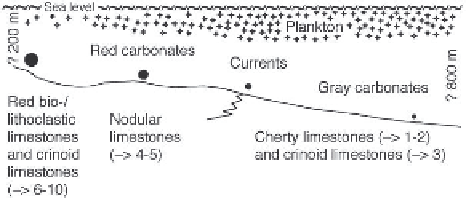Geology Reference
In-Depth Information
Plate 139 Pelagic DeeperMarine Limestones: Early Jurassic of the Northern Calcareous Alps
In the Adnet area near Salzburg (Austria), Late Triassic reef and basinal carbonates are overlain by Jurassic
sediments. The deposition of Liassic hemipelagic and pelagic sediments was controlled by the inherited Triassic
relief. The basinal Triassic Kössen beds pass continuously into the Liassic Kendlbach Formation and further on
into the gray cherty limestones of the Scheibelberg Formation. The former reef and upper slope were covered by
red condensed limestones of the Adnet Formation characterized by poorly bedded limestones with ammonites (-> 9)
and Fe-Mn crusts. Thin sections contain organic debris (-> 1, 4), ostracods, (-> 8), echinoderms (crinoids; -> 6),
sponge spicules, dwarf gastropods, juvenile ammonites, foraminifera (nodosariids and involutinids, -> 7;
textulariids), and
Globochaete
. Reworked hardground clasts (-> 8, 10) and intraclasts may be common. The
source of the pelagic and hemipelagic micrite matrix was nannoplankton (
Schizosphaerella
), and probably also
input from platforms. The microfacies was studied by Böhm (1992) and Böhm et al. (1999).
The plate displays the microfacies of the limestones in the Sinemurian-Carixian Scheibelberg Formation (->
1-3; Fig. 15.36) and the coeval red limestones in the Adnet Formation (-> 4-10) with well-known ammonite-
bearing limestones used since Roman times as decorative stone in southern and central Europe.
1
Gray burrowed microbioclastic packstone.
Fossils are predominantly sponge spicules (arrows) and thin-shelled ostra-
cods. The rock appears mottled because of burrowing. Interpretation: Lime muds consisting of calcareous plankton
(
Schizosphaerella
) and deposited on the poorly aerated nutrient-rich deeper slope inhabited by abundant sponges. Water
depths are believed to be several hundred meters. Scheibelberg limestone (Sinemurian): Osterhorn Mountains, Austria.
2
Cherts
are common within the gray sponge-ostracod limestones. Take a look at the well-preserved sponge spicules (ar-
rows). Nodular cherts in limestones can provide an important window on the original biota, sediment composition and
diagenetic history of the host rocks, because of their low susceptibility to further diagenetic alteration. Same locality as -> 1.
3 Intercalations of crinoid-intraclast packstone within the Scheibelberg limestone, forming distinct, up to 30 cm thick beds.
Arrows point to syntaxial rim cement around echinoderm fragments. Interpretation: Turbidites. The source area may be
located on a swell with crinoid meadows. Plattenbruch, Adnet, southeast of Salzburg, Austria.
4 Transitional facies between the deeper Scheibelberg limestone and the red Adnet limestone, characterized by a red nodu-
lar microbioclastic wackestone. Interpretation: Deeper aerated slope environment. Breitenberg, Lake Wolfgang, Austria.
5 Red nodular Adnet limestone. Nodules (N) and matrix (M) are pelagic microbioclastic wackestones. Small calcite-filled
structures are ostracods. Shells and echinoderms also occur. Interpretation: Mud deposition within a well-aerated slope
environment below the photic zone and within the range of the aragonite lysocline. Nutrient input reduced by stronger
bottom currents. Sporadical reduction in sedimentation rates resulted in complete oxidation of the sediment and patchy
and local cementation of the mud. Kieferbruch, Adnet.
6 Red crinoid packstone/wackestone. Thin- to medium-bedded limestones. Interpretation: Accumulation of echinoderm
fragments within depressions or fissures of swells caused by drowning of Upper Triassic reefs. Adnet, Austria.
7-9 Red lithoclastic crinoid-shell wackestone, characterized by diverse benthic foraminifera (-> 7:
Involutina liassica
: I and
lagenids: L), echinoderms (E) and ostracods (-> 8), dissolved aragonite shells (-> 9, ammonites) and reworked hard-
ground clasts, indicating the existence of strong bottom currents (-> 8). Interpretation: Well aerated deep-water environ-
ment, within the range of the aragonite lysocline. All samples from the Marmorbruch Adnet.
10 Red bioclastic wackestone/packstone with common hardground lithoclasts. Note the ferruginous coating (arrow). Pre-
vailing fossils are ostracods and mollusk debris. Thick-bedded limestones. Interpretation: Upper slope environment with
currents producing low sedimentation rates and erosion of hardground clasts. Adnet.
Fig. 15.36.
Jurassic pelagic carbonates
. Depositional model
for Early Jurassic (Sinemurian-Carixian) deep-water lime-
stones in the Adnet area near Salzburg (Austria). Slope set-
ting and deeper basinal setting are an inherited Rhaetian to-
pography consisting of a shallow reef zone and a marly ba-
sin. Jurassic sedimentation continued in parts of the Triassic
basin but was interrupted during the lowermost Jurassic in
areas over former reef swells. Reduced sedimentation is re-
corded by hardgrounds and ferruginous crusts in the Lower
Adnet Formation that includes the famous red limestones and red nodular limestones, commonly summarized under the
name Adnet limestone. Deeper basinal limestones are represented by gray cherty carbonates. The sedimentation was con-
trolled by increasing plankton production triggered by enhanced upwelling. Bottom currents controlled the deposition of
fine carbonate mud, the input of nutrients and the oxygenation of bottom waters. Water depths are inferred from the dip,
geometry and microfacies. Width of the sketch is about 10 km. The arrows indicate characteristic microfacies types shown in
Plate 139. Modified from Böhm (1992).

